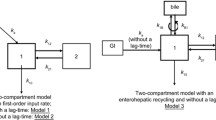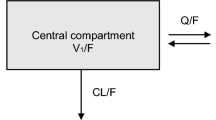Abstract
Background: Therapeutic drug monitoring of mycophenolic acid (MPA) may minimise the risk of acute rejection after transplantation. Area under the curve (AUC) rather than trough concentration-based monitoring is recommended and models for AUC estimation are needed.
Objective: To develop a population pharmacokinetic model suitable for Bayesian estimation of individual AUC in stable renal transplant patients. Patients and methods: The population pharmacokinetics of MPA were studied using nonlinear mixed effects modelling (NONMEM) in 60 patients (index group) receiving MPA on a twice-daily basis. Ten blood samples were collected at fixed timepoints from ten patients and four blood samples were collected at sparse timepoints from 50 patients. Bayesian estimation of individual AUC was made on the basis of three blood concentration measurements and covariates. The predictive performances of the Bayesian procedure were evaluated in an independent group of patients (test group) comprising ten subjects in whom ten blood samples were collected at fixed timepoints.
Results: A two-compartment model with zero-order absorption best fitted the data. Covariate analysis showed that bodyweight was positively correlated with oral clearance. However, the weak magnitude of the reduction in variability (from 34.8 to 28.2%) indicates that administration on a per kilogram basis would be of limited value in decreasing interindividual variability in MPA exposure. Bayesian estimation of pharmacokinetic parameters using samples drawn at 20 minutes and 1 and 3 hours enabled estimation of individual AUC with satisfactory accuracy (bias 7.7%, range of prediction errors 0.43–15.1%) and precision (root mean squared error 12.4%) as compared with the reference value obtained using the trapezoidal method.
Results: This paper reports for the first time population pharmacokinetic data for MPA in stable renal transplant patients, and shows that Bayesian estimation can allow accurate prediction of AUC with only three samples. This method provides a tool for therapeutic drug monitoring of MPA or for concentration-effect studies. Its application to MPA monitoring in the early period post-transplantation needs to be evaluated.









Similar content being viewed by others
Notes
The use of trade names is for product identification purposes only and does not imply endorsement.
References
Bullingham RE, Nicholls AJ, Kamm BR. Clinical pharmacokinetics of mycophenolate mofetil. Clin Pharmacokinet 1998; 34(6): 429–55
Cantin B, Giannetti N, Parekh H, et al. Mycophenolic acid concentrations in long-term heart transplant patients: relationship with calcineurin antagonists and acute rejection. Clin Transplant 2002; 16(3): 196–201
DeNofrio D, Loh E, Kao A, et al. Mycophenolic acid concentrations are associated with cardiac allograft rejection. J Heart Lung Transplant 2000; 19(11): 1071–6
Dubrey SW, Holt DW, Banner N. Measurement of mycophenolate mofetil plasma levels after heart transplantation and a potential side effect of high levels. Ther Drug Monit 1999; 21(3): 325–6
Hale MD, Nicholls AJ, Bullingham RE, et al. The pharmacokinetic-pharmacodynamic relationship for mycophenolate mofetil in renal transplantation. Clin Pharmacol Ther 1998; 64(6): 672–83
Hubner GI, Eismann R, Sziegoleit W. Relationship between mycophenolate mofetil side effects and mycophenolic acid plasma trough levels in renal transplant patients. Arzneimittel Forschung 2000; 50(10): 936–40
Pillans PI, Rigby RJ, Kubler P, et al. A retrospective analysis of mycophenolic acid and cyclosporin concentrations with acute rejection in renal transplant recipients. Clin Biochem 2001; 34(1): 77–81
Sanquer S, Breil M, Baron C, et al. Trough blood concentrations in long-term treatment with mycophenolate mofetil [letter]. Lancet 1998; 351(9115): 1557
Shaw LM, Nowak I. Mycophenolic acid: measurement and relationship to pharmacologic effects. Ther Drug Monit 1995; 17(6): 685–9
Smak Gregoor PJ, Hesse CJ, van Gelder T, et al. Relation of mycophenolic acid trough levels and adverse events in kidney allograft recipients. Transplant Proc 1998; 30(4): 1192–3
Takahashi K, Ochiai T, Uchida K, et al. Pilot study of mycophenolate mofetil (RS-61443) in the prevention of acute rejection following renal transplantation in Japanese patients. RS-61443 Investigation Committee: Japan. Transplant Proc 1995; 27(1): 1421–4
Oellerich M, Shipkova M, Schutz E, et al. Pharmacokinetic and metabolic investigations of mycophenolic acid in pediatric patients after renal transplantation: implications for therapeutic drug monitoring. German Study Group on Mycophenolate Mofetil Therapy in Pediatric Renal Transplant Recipients. Ther Drug Monit 2000; 22(1): 20–6
Weber LT, Shipkova M, Armstrong VW, et al. The pharmacokinetic-pharmacodynamic relationship for total and free mycophenolic acid in pediatric renal transplant recipients: a report of the German study group on mycophenolate mofetil therapy. J Am Soc Nephrol 2002; 13(3): 759–68
Nicholls AJ. Opportunities for therapeutic monitoring of mycophenolate mofetil dose in renal transplantation suggested by the pharmacokinetic/pharmacodynamic relationship for mycophenolic acid and suppression of rejection. Clin Biochem 1998; 31(5): 329–33
van Gelder T, Hilbrands LB, Vanrenterghem Y, et al. A randomized double-blind, multicenter plasma concentration controlled study of the safety and efficacy of oral mycophenolate mofetil for the prevention of acute rejection after kidney transplantation. Transplantation 1999; 68(2): 261–6
Mourad M, Malaise J, Chaib Eddour D, et al. Pharmacokinetic basis for the efficient and safe use of low-dose mycophenolate mofetil in combination with tacrolimus in kidney transplantation. Clin Chem 2001; 47(7): 1241–8
Weber LT, Shipkova M, Armstrong VW, et al. Comparison of the Emit immunoassay with HPLC for therapeutic drug monitoring of mycophenolic acid in pediatric renal-transplant recipients on mycophenolate mofetil therapy. Clin Chem 2002; 48(3): 517–25
Shaw LM, Holt DW, Oellerich M, et al. Current issues in therapeutic drug monitoring of mycophenolic acid: report of a roundtable discussion. Ther Drug Monit 2001; 23(4): 305–15
Cattaneo D, Gaspari F, Ferrari S, et al. Pharmacokinetics help optimizing mycophenolate mofetil dosing in kidney transplant patients. Clin Transplant 2001; 15(6): 402–9
Holt DW. Monitoring mycophenolic acid. Ann Clin Biochem 2002; 39 (Pt 3): 173–83
Wong SH. Therapeutic drug monitoring for immunosuppressants. Clin Chim Acta 2001; 313(1–2): 241–53
Mourad M, Wallemacq P, Konig J, et al. Therapeutic monitoring of mycophenolate mofetil in organ transplant recipients: is it necessary? Clin Pharmacokinet 2002; 41(5): 319–27
Stephan A, Masri MA, Barbari A, et al. Therapeutic drug level monitoring for mycophenolate mofetil: is it justified? Transplant Proc 2001; 33(5): 2778–9
Dumont RJ, Ensom MH. Methods for clinical monitoring of cyclosporin in transplant patients. Clin Pharmacokinet 2000; 38(5): 427–47
Filler G, Mai I. Limited sampling strategy for mycophenolic acid area under the curve. Ther Drug Monit 2000; 22(2): 169–73
Le Guellec C, Buchler M, Giraudeau B, et al. Simultaneous estimation of cyclosporin and mycophenolic acid areas under the curve in stable renal transplant patients using a limited sampling strategy. Eur J Clin Pharmacol 2002; 57(11): 805–11
Schutz E, Armstrong VW, Shipkova M, et al. Limited sampling strategy for the determination of mycophenolic acid area under the curve in pediatric kidney recipients: German Study Group on MMF Therapy in Pediatrie Renal Transplant Recipients. Transplant Proc 1998; 30(4): 1182–4
Weber LT, Schutz E, Lamersdorf T, et al. Therapeutic drug monitoring of total and free mycophenolic acid (MPA) and limited sampling strategy for determination of MPA-AUC in paediatric renal transplant recipients: The German Study Group on Mycophenolate Mofetil (MMF) Therapy. Nephrol Dial Transplant 1999; 14 Suppl. 4: 34–5
Willis C, Taylor PJ, Salm P, et al. Evaluation of limited sampling strategies for estimation of 12-hour mycophenolic acid area under the plasma concentration-time curve in adult renal transplant patients. Ther Drug Monit 2000; 22(5): 549–54
Yeung S, Tong KL, Tsang WK, et al. Determination of mycophenolate area under the curve by limited sampling strategy. Transplant Proc 2001; 33(1–2): 1052–3
Tanigawara Y, Yano I, Kawakatsu K, et al. Predictive performance of the Bayesian analysis: effects of blood sampling time, population parameters, and pharmacostatistical model. J Pharmacokinet Biopharm 1994; 22(1): 59–71
Aarons L. Software for population pharmacokinetics and pharmacodynamics. Clin Pharmacokinet 1999; 36(4): 255–64
Proost JH. Adaptive control of drug dosage regimens using maximum a posteriori probability Bayesian fitting. Int J Clin Pharmacol Ther 1995; 33(10): 531–6
Vozeh S, Steimer JL, Rowland M, et al. The use of population pharmacokinetics in drug development. Clin Pharmacokinet 1996; 30(2): 81–93
Sheiner LB, Beal SL. Some suggestions for measuring predictive performance. J Pharmacokinet Biopharm 1981; 9(4): 503–12
Weber LT, Lamersdorf T, Shipkova M, et al. Area under the plasma concentration-time curve for total, but not for free, mycophenolic acid increases in the stable phase after renal transplantation: a longitudinal study in pediatric patients: German Study Group on Mycophenolate Mofetil Therapy in Pediatrie Renal Transplant Recipients. Ther Drug Monit 1999; 21(5): 498–506
Pawinski T, Hale M, Korecka M, et al. Limited sampling strategy for the estimation of mycophenolic acid area under the curve in adult renal transplant patients treated with concomitant tacrolimus. Clin Chem 2002; 48(9): 1497–504
Buffington DE, Lampasona V, Chandler MH. Computers in pharmacokinetics: choosing software for clinical decision making. Clin Pharmacokinet 1993; 25(3): 205–16
Charpiat B, Falconi I, Breant V, et al. A population pharmacokinetic model of cyclosporine in the early postoperative phase in patients with liver transplants, and its predictive performance with Bayesian fitting. Ther Drug Monit 1998; 20(2): 158–64
Ducharme MP, Verret L, Brouillette D, et al. Ability of a firstpass pharmacokinetic model to characterize cyclosporine blood concentrations after administrations of Sandimmune or Neoral formulations. Ther Drug Monit 1998; 20(2): 165–71
Ruggeri A, Martinelli M. A program for the optimization of cyclosporine therapy using population kinetics modeling. Comput Methods Programs Biomed 2000; 61(1): 61–9
Debord J, Risco E, Harel M, et al. Application of a gamma model of absorption to oral cyclosporin. Clin Pharmacokinet 2001; 40(5): 375–82
Leger F, Debord J, Le Meur Y, et al. Maximum a posteriori Bayesian estimation of oral cyclosporin pharmacokinetics in patients with stable renal transplants. Clin Pharmacokinet 2002; 41(1): 71–80
Meier-Kriesche HU, Shaw LM, Korecka M, et al. Pharmacokinetics of mycophenolic acid in renal insufficiency. Ther Drug Monit 2000; 22(1): 27–30
Shaw LM, Korecka M, Aradhye S, et al. Mycophenolic acid area under the curve values in African American and Caucasian renal transplant patients are comparable. J Clin Pharmacol 2000; 40(6): 624–33
Vogl M, Weigel G, Seebacher G, et al. Evaluation of the EMIT mycophenolic acid assay from Dade Behring. Ther Drug Monit 1999; 21(6): 638–43
Funaki T. Enterohepatic circulation model for population pharmacokinetic analysis. J Pharm Pharmacol 1999; 51(10): 1143–8
Brown NW, Aw MM, Mieli-Vergani G, et al. Mycophenolic acid and mycophenolic acid glucuronide pharmacokinetics in pediatric liver transplant recipients: effect of cyclosporine and tacrolimus comedication. Ther Drug Monit 2002; 24(5): 598–606
Schutz E, Shipkova M, Wieland E, et al. Evaluation of an immunoassay for mycophenolic acid. Ther Drug Monit 2000; 22(1): 141–2
Beal JL, Jones CE, Taylor PJ, et al. Evaluation of an immunoassay (EMIT) for mycophenolic acid in plasma from renal transplant recipients compared with a high-performance liquid chromatography assay. Ther Drug Monit 1998; 20(6): 685–90
Acknowledgements
We gratefully acknowledge the financial support of Limoges University Hospital and Dade-Behring, Paris La Défense, France. The authors have no conflicts of interest that are directly relevant to the content of this study.
Author information
Authors and Affiliations
Corresponding author
Rights and permissions
About this article
Cite this article
Le Guellec, C., Bourgoin, H., Büchler, M. et al. Population Pharmacokinetics and Bayesian Estimation of Mycophenolic Acid Concentrations in Stable Renal Transplant Patients. Clin Pharmacokinet 43, 253–266 (2004). https://doi.org/10.2165/00003088-200443040-00004
Published:
Issue Date:
DOI: https://doi.org/10.2165/00003088-200443040-00004




